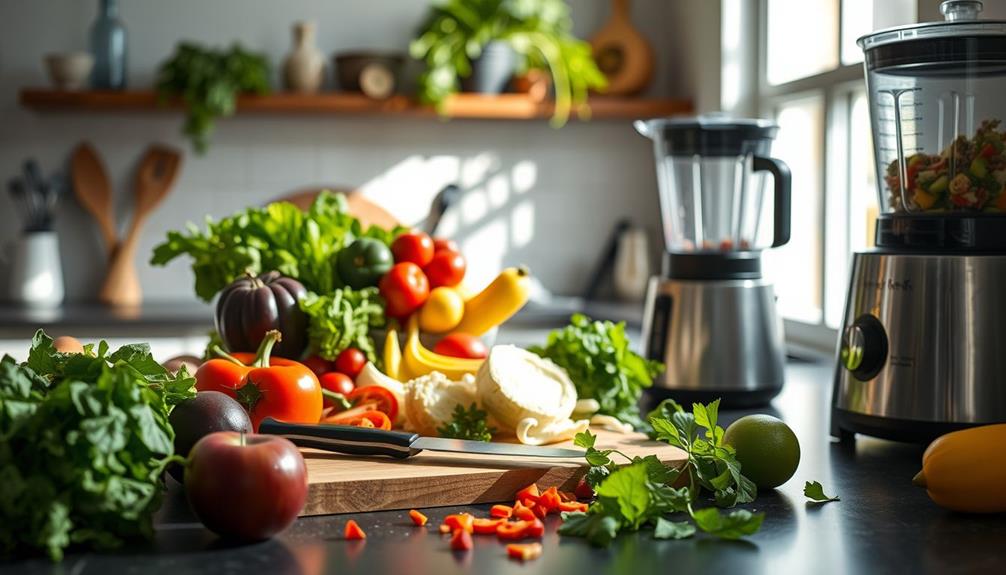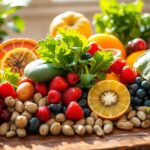Raw food can be beneficial for you, offering higher nutrient density and potential weight loss. You'll enjoy increased energy, improved digestion, and a reduced risk of chronic diseases. However, you must be cautious about nutrient deficiencies, particularly vitamin B12 and iron. The high fiber content can lead to digestive discomfort, and there's a risk of foodborne illness from raw items, especially if you're vulnerable. A balanced approach, combining raw and cooked foods, can maximize the benefits while minimizing the risks. There's much more to uncover about this diet, including practical tips and expert insights that can guide your journey.
Key Takeaways
- Raw food diets can increase nutrient intake, providing vitamins, minerals, and antioxidants that support overall health and well-being.
- While raw foods promote weight loss and digestive health, they can lead to deficiencies in essential nutrients like vitamin B12 and iron.
- Cooking food can enhance nutrient availability, making a balanced approach of raw and cooked foods more beneficial.
- Raw diets may pose food safety risks, increasing exposure to foodborne illnesses and natural toxins if not prepared properly.
- Gradual incorporation of raw foods and community support can ease the transition while maximizing health benefits.
Overview of the Raw Food Diet
The raw food diet focuses on eating uncooked and unprocessed foods, which means you'll primarily enjoy fruits, vegetables, nuts, seeds, and sprouted grains. This approach aims to preserve nutrients and enzymes, with a temperature limit of 104-118°F (40-48°C) during preparation.
You can prepare raw foods through methods like juicing, blending, dehydrating, soaking, and sprouting, all designed to maintain the natural state of the ingredients. Additionally, incorporating high antioxidant foods like celery and beetroot can enhance the nutritional profile of your meals.
There are three main types of raw food diets: raw vegan, raw vegetarian, and raw omnivorous. The raw vegan diet excludes all animal products, while the raw vegetarian diet allows for raw dairy and eggs. The raw omnivorous diet includes raw animal products and meats.
Advocates of the raw food diet often report health benefits such as increased energy, weight loss, and lower risks of chronic diseases, thanks to the high intake of fruits and vegetables.
However, you should be aware that a raw food diet can lead to nutrient deficiencies, particularly in vitamin B12, iron, and omega-3 fatty acids. To enjoy the benefits while minimizing risks, careful planning is essential for balanced nutrition.
Health Benefits of Raw Foods

When you choose raw foods, you're not just adding more fruits and vegetables to your plate; you're boosting your nutrient intake and variety.
This can enhance your digestive health and lower your risk of chronic diseases.
Additionally, incorporating essential oils like essential oils for toothache relief can complement your raw food diet by providing natural remedies for various ailments.
With all these benefits, it's clear that embracing raw foods can lead to a healthier lifestyle.
Nutrient Density and Variety
How can a raw food diet enhance your health? A raw food diet is packed with nutrient-dense fruits, vegetables, nuts, and seeds. These foods are rich in vitamins, minerals, and antioxidants that can greatly boost your overall health and skin vitality.
Additionally, incorporating herbal teas like the best herbal tea for period pain can further support your well-being during your raw food journey. By consuming a variety of raw foods, you increase your chances of getting a broad spectrum of nutrients essential for preventing deficiencies.
The high fiber content in raw foods not only aids digestion but also promotes satiety, which can help with weight loss. Studies have shown that people on raw diets can lose between 22 to 26 pounds over 3.5 years.
Additionally, a raw diet is associated with lower risks of chronic diseases, like heart disease and type 2 diabetes, thanks to its high nutrient density and low calorie density.
Focusing on seasonal and local produce not only maximizes flavor and nutrition but also enhances your dietary adherence and enjoyment. Embracing variety in your raw foods can lead to better health outcomes, making it an appealing and beneficial choice for many.
Digestive Health Enhancement
Raw foods can considerably enhance your digestive health, providing a natural solution for many common gastrointestinal issues. When you incorporate more raw fruits and vegetables into your diet, you can experience a wealth of benefits that improve your overall well-being.
Additionally, raw foods often contain beneficial compounds that can support immune function, which is essential for maintaining good digestive health common types of cold medications.
- High in dietary fiber: Raw foods promote regular bowel movements and prevent constipation.
- Supports gut microbiome: A healthy variety of raw foods can enhance your gut microbiome, reducing inflammation.
- Boosts nutrient absorption: The natural enzymes in raw foods may help break down food, improving nutrient absorption.
- Increases hydration: Many raw fruits and vegetables have high water content, essential for ideal digestion.
Chronic Disease Risk Reduction
Eating a diet rich in raw foods can greatly lower your risk of chronic diseases. Raw food diets, packed with fruits and vegetables, contribute to better heart health by reducing high blood pressure by an impressive 75%. This reduction not only protects your heart but also enhances your overall cardiovascular health.
Furthermore, the high vitamin and antioxidant levels in raw foods boosts immune system function, which is essential for preventing chronic diseases.
The increased fiber intake from raw foods plays an important role in lowering the risk of type 2 diabetes, supporting healthy digestion, and regulating blood sugar levels. In addition, those who embrace raw food diets often experience notable weight loss, averaging 22-26 pounds over 3.5 years, which further diminishes the risk of obesity-related chronic diseases.
Antioxidants found in raw fruits and vegetables help lower cholesterol and triglyceride levels, lending additional support to your cardiovascular health.
Nutritional Risks and Deficiencies

When you stick to a raw food diet, you might miss out on essential nutrients like vitamin B12, calcium, and iron, which can affect your overall health.
It's important to contemplate the financial considerations for elderly care as deficiencies can lead to increased medical costs down the line.
Inadequate protein intake can also become a concern, potentially harming your muscle maintenance and bone density.
If you're not careful about balancing your diet, these deficiencies can lead to serious long-term health issues.
Essential Nutrient Deficiencies
A raw food diet might seem appealing for its health benefits, but it often leads to essential nutrient deficiencies. If you're not careful, you could miss out on vital vitamins and minerals that support your overall well-being.
Key nutrients like vitamin B12, calcium, and vitamin D are primarily found in animal products, and their absence can pose serious health risks, including anemia and compromised bone health. Additionally, women should be aware of the importance of regular screenings for conditions like breast cancer, as early detection can be crucial for treatment outcomes, especially when considering dietary changes that may affect overall health mammography aims to detect breast cancer early.
Consider these potential deficiencies:
- Vitamin B12: Essential for nerve function and energy production.
- Calcium: Vital for strong bones; insufficient intake raises osteoporosis risk.
- Vitamin D: Critical for calcium absorption; low levels can weaken bones.
- Protein intake: Inadequate protein can affect muscle mass and density.
Additionally, high fruit consumption can lead to dental erosion due to increased mouth acidity. Nutritional imbalances from poorly planned raw diets may also result in menstrual irregularities, with many women experiencing issues like amenorrhea.
To enjoy the benefits of a raw food diet, it's vital to thoughtfully plan meals to avoid these essential nutrient deficiencies and maintain a balanced lifestyle.
Protein and Iron Concerns
While many people are drawn to the raw food diet for its perceived health benefits, concerns about protein and iron intake shouldn't be overlooked. Following a raw food diet can lead to inadequate protein intake, as most raw plant sources have lower protein levels compared to animal products. This deficiency can affect your muscle maintenance and repair, which is vital for overall health.
Additionally, diversification strategy in your food choices is necessary to guarantee you meet your nutritional needs. Iron absorption poses another challenge. The non-heme iron found in plant sources is less bioavailable than heme iron from animal products, increasing your risk of iron deficiency anemia. If you're a vegetarian or vegan, you may need to rely on specific plant-based foods like lentils and chickpeas, as well as fortified products, to meet your protein and iron needs.
To address these potential deficiencies, supplementation of vitamin B12 and iron might be necessary, especially if you're on a long-term raw food diet. A well-planned raw food diet that includes a variety of foods can help mitigate these nutritional risks, but if you're not careful, you could face health issues related to low protein and iron levels.
Prioritizing these nutrients is essential for your well-being.
Types of Raw Food Diets

Raw food diets come in various forms, each catering to different dietary preferences and philosophies. Many people are increasingly exploring raw food options for their potential health benefits, such as improved digestion and increased energy levels.
You can choose a style that aligns with your beliefs and lifestyle, whether it's focused on plants or includes animal products. Here are the main types:
- Raw vegan diet: This strictly excludes all animal products, emphasizing uncooked plant foods that are minimally heated, typically below 104–118°F (40–48°C).
- Raw vegetarian diet: This allows for raw dairy and eggs, offering more variety while still focusing on uncooked plant foods.
- Raw omnivorous diet: This incorporates raw animal products like meat, fish, and dairy alongside plant-based foods, appealing to those who want animal proteins in their diet.
- Variability in dietary practices: Some individuals strictly adhere to raw foods, while others may include limited cooked items, such as sun-dried or dehydrated foods.
Understanding these options can help you make informed choices about your meals.
Whether you lean toward a raw vegan lifestyle or prefer a raw omnivorous approach, each type of raw food diet has unique benefits and risks to weigh. For more detailed insights on maintaining a healthy diet, check out ultimate hamster care.
Food Preparation Techniques

When it comes to a raw food diet, employing effective food preparation techniques is essential for maximizing nutritional benefits. These methods help maintain the nutritional integrity of your raw ingredients while enhancing their nutrient availability.
| Technique | Purpose | Benefits |
|---|---|---|
| Soaking | Reduces anti-nutrients | Improves digestibility of beans and grains |
| Sprouting | Activates enzymes | Increases nutrient availability |
| Dehydrating | Preserves foods | Creates snacks while retaining nutrients |
Juicing extracts liquid from fruits and vegetables, providing a concentrated source of vitamins and minerals, though it may lack fiber. Meanwhile, blending allows you to create smoothies and soups, making it easier to consume a variety of raw ingredients, consequently boosting your overall nutrient intake.
Pros of a Raw Food Diet

A raw food diet offers numerous benefits that can greatly enhance your overall health. By focusing on nutrient-dense fruits and vegetables, you can enjoy a variety of advantages:
- Improved nutrient intake: The vitamins and minerals in raw foods may lead to better skin health and increased energy levels. Additionally, incorporating a balanced diet rich in fruits and vegetables can further support your well-being, as emphasized in lifestyle for longevity.
- Enhanced digestive health: The high fiber content promotes regularity and can reduce the risk of gastrointestinal disorders.
- Effective weight loss: With lower calorie density, raw food diets can help you shed pounds, with participants losing an average of 22-26 pounds over 3.5 years.
- Lowered risk of chronic diseases: By eliminating processed foods and added sugars, you may experience lower blood pressure and cholesterol levels, potentially reducing your risk of heart disease and diabetes.
Incorporating a raw food diet can transform your dietary habits, contributing to long-term health benefits.
You'll likely find that eating fresh, whole foods not only improves your physical well-being but can also positively impact your mental health. Embracing this lifestyle may be an excellent step towards a healthier you!
Cons of a Raw Food Diet

When you consider a raw food diet, you should be aware of some significant drawbacks.
You might face nutrient deficiencies, digestive issues, and food safety concerns that can impact your health.
It's important to weigh these risks against the benefits before making a decision.
Nutrient Deficiencies Risk
How can a raw food diet impact your nutrient intake? While fresh fruits and vegetables are beneficial, relying solely on raw foods can lead to significant nutrient deficiencies. Specifically, you might miss out on essential nutrients commonly found in animal products, like:
- Vitamin B12: Key for nerve function and red blood cell formation.
- Calcium: Essential for bone health; inadequate intake can lead to lower bone mass.
- Protein: Insufficient protein intake can hinder muscle maintenance and repair, risking muscle wasting.
- Omega-3 Fatty Acids: Important for heart and brain health, often lacking in raw diets.
Additionally, a high-fruit diet can increase acidity, raising the risk of tooth decay.
If you're not careful, the restrictive nature of a raw food diet may result in inadequate caloric intake, which can lead to weight loss and related health issues. This is particularly concerning for women, who may experience menstrual irregularities due to nutrient shortages.
Digestive Issues Potential
Experiencing digestive issues is a common concern for those on a raw food diet. The high fiber content of raw fruits and vegetables can lead to bloating, gas, and discomfort, especially if your body isn't used to it. Additionally, raw foods often contain anti-nutrients like phytic acid and lectins, which can interfere with nutrient absorption and cause gastrointestinal distress.
Here's a quick overview of potential digestive issues related to a raw food diet:
| Issue | Cause | Effect |
|---|---|---|
| Bloating and Gas | High fiber content | Discomfort and abdominal pressure |
| Nutrient Absorption | Anti-nutrients | Reduced nutrient intake |
| Muscle Mass Loss | Inadequate protein sources | Decreased strength and energy |
Furthermore, some raw foods, like cruciferous vegetables, can be particularly hard to digest. The absence of cooked foods may hinder your digestive enzyme production, making it challenging to break down complex carbohydrates and proteins. Be mindful of these factors if you're considering a raw food diet.
Food Safety Concerns
While digestive issues can make the raw food diet challenging, food safety concerns present another important risk. Eating raw foods, especially animal products like dairy, eggs, and meat, can lead to severe health risks due to harmful bacteria and pathogens.
You mightn't realize that improperly prepared raw foods can expose you to:
- Foodborne illness from E. coli and Salmonella
- Natural toxins in certain raw foods, like kidney beans
- Increased infections from consuming raw dairy products
- Bacterial risks due to inadequate washing
The lack of proper cooking methods means that harmful bacteria and parasites can thrive, greatly raising your risk of food poisoning.
Even washing raw fruits and vegetables thoroughly doesn't eliminate all dangers. Unpasteurized items, like raw dairy products, come with heightened infection risks, further complicating your food safety measures.
Before diving into a raw food diet, it's essential to weigh these health risks.
Make informed choices about the raw foods you consume, and consider how you're handling and preparing them to minimize potential food safety issues.
Safety Concerns With Raw Foods

When considering raw foods, safety concerns should be at the forefront of your mind. Consuming raw foods, particularly animal products like meat, dairy, and eggs, poses significant health risks due to potential contamination with harmful bacteria such as E. coli, Salmonella, and Listeria. These can lead to severe foodborne illnesses, especially for vulnerable populations like pregnant women, children, the elderly, and those with weakened immune systems, who should avoid raw foods entirely.
Additionally, certain raw foods, such as kidney beans and cassava, contain natural toxins that can be harmful if not properly prepared. To reduce the risk of contamination, it's essential to practice thorough washing of raw fruits and vegetables, as pathogens can linger on their surfaces.
You should also be aware that consuming some raw foods can contribute to dental issues. Fruits with high acidity levels can lead to increased dental erosion, so managing your diet is important for maintaining good oral health.
Practical Tips for Beginners

Diving into a raw food diet can feel overwhelming, but with the right approach, you can make the change smoother and more enjoyable. Start gradually by incorporating raw foods into your meals, aiming for at least 50% raw content each day. This helps your body adjust without feeling deprived.
Here are some practical tips to ease your adjustment:
- Invest in essential kitchen appliances like a high-quality blender and food processor for effortless meal preparation.
- Focus on seasonal produce and locally sourced ingredients to maximize flavor and nutrition while keeping costs down.
- Join online communities or local groups dedicated to raw food diets for support, recipe ideas, and motivation.
- Experiment with preparation methods like soaking, sprouting, and dehydrating to enhance flavors and textures in your healthy foods.
Expert Opinions on Raw Diets

Experts in nutrition have mixed feelings about raw food diets. While they recognize that a raw food diet can boost your intake of vitamins, minerals, and antioxidants, they caution against potential nutrient deficiencies. Essential nutrients like vitamin B12, iron, and protein might fall short if your diet isn't carefully planned.
Some nutritionists point out that the restrictive nature of these diets can complicate adherence, leading to boredom or even social isolation during meals. Research shows that while you might experience weight loss and improved digestive health on a raw food diet, it's vital to balance raw foods with cooked options. This balance enhances nutrient bioavailability, meaning your body can absorb more nutrients.
Additionally, long-term adherence to a strictly raw food diet could result in menstrual irregularities, with some studies linking it to a higher risk of amenorrhea in women.
Because of these risks, many health professionals advocate for a balanced approach. Incorporating both raw and cooked foods allows you to maximize nutrient intake while minimizing the chances of deficiencies. By taking a more flexible stance, you can enjoy the benefits of raw foods without compromising your overall health.
Frequently Asked Questions
Is a Raw Food Diet Healthy for Humans?
A raw food diet can be healthy for you, offering high nutrient content and fiber. However, if you don't plan carefully, you might miss essential vitamins and minerals, posing potential health risks. Balance is key. It is important to include a variety of raw fruits, vegetables, nuts, and seeds in your diet to ensure that you are getting all of the essential nutrients your body needs. The benefits of raw food include improved digestion, increased energy levels, and a lower risk of chronic diseases. By carefully planning your raw food meals and ensuring that you are getting a wide range of nutrients, you can enjoy the health benefits of a raw food diet while minimizing any potential health risks.
What Are the Pros and Cons of a Raw Food Diet?
Imagine vibrant fruits and crisp veggies filling your plate. You'll enjoy boosted nutrients and weight loss, but watch out for potential deficiencies and foodborne risks. Balancing those benefits and drawbacks is essential for your health.
What Is the Disadvantage of Eating Raw Foods?
Eating raw foods can lead to nutrient deficiencies, digestive issues, and increased risk of foodborne illnesses. You might also face dental problems and potential menstrual irregularities, complicating your health and social interactions.
Is Raw Food High Risk?
Yes, raw food can be high risk. You face potential foodborne illnesses, nutrient deficiencies, and dental issues. Certain raw items contain toxins, and long-term adherence might even affect your menstrual health and fertility.
Conclusion
To sum up, embracing a raw food diet can offer numerous health benefits, with studies showing that nearly 50% of raw food enthusiasts report increased energy levels. However, it's crucial to be aware of potential nutritional deficiencies and safety concerns. By incorporating a variety of foods and practicing safe food handling, you can enjoy the perks of this lifestyle while minimizing risks. If you're curious, start small and see how your body responds to this vibrant way of eating!

















